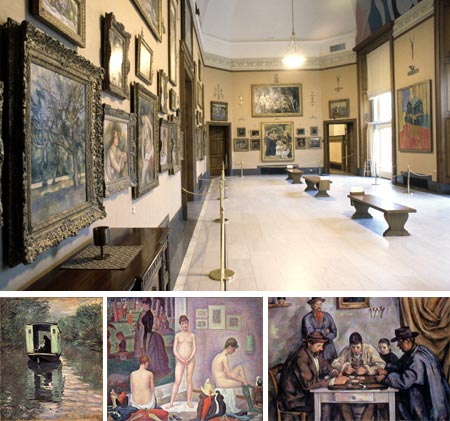The Case of the Barnes
by Marion Maneker
From: Art Market Monitor 9/14/09
Not to beat a dead deaccessioning horse. But Christopher Knight raises again the issue of the Barnes Foundation move on the occasion of the premiere at the Toronto Film Festival of “The Art of the Steal,” a documentary on the case. At the risk of seeming to promote one side of the Barnes issue or another, there remains a fundamental conflict between the emphasis on art as being held in the public trust and honoring donor intent.
A cinematic primer on how to seize control of billions of dollars worth of post-Impressionist and early Modern art all for a modest investment of $150 million has its world premiere Saturday at the Toronto International Film Festival.
The much-anticipated documentary “The Art of the Steal: The Untold Story of the Barnes Foundation” looks at the shrewdly engineered takeover of arguably the nation’s greatest early 20th century cultural monument. Dubbed by critics a “legal theft,” the disastrous plan is to dismantle the Barnes and move it from its historic home in suburban Philadelphia to a tourist location close to downtown.
Indeed the condescending tone of “tourist location” does not sit comfortably next to the concept of pubic trust (even if the Barnes Foundation is not/was not a public institution.) But then again, maybe we’re just being argumentative. Don Argott, the movie’s director, explains that the Barnes did not make much of an effort to explain their side of the story.
###
The Barnes Foundation is an educational art institution in Lower Merion Township, a suburb of Philadelphia, Pennsylvaniain the United States. It was founded in 1922 by Albert C. Barnes, who collected art after making a fortune by co-developing an early antimicrobial drug marketed as Argyrol.
Today, the Foundation possesses more than 2500 objects, including 800 paintings estimated to be worth more than $6 billion. Among its collection are 181 paintings by Pierre-Auguste Renoir, 69 by Paul Cézanne, and 59 by Henri Matisse, as well as numerous other masters, including George de Chirico, Paul Gauguin, El Greco, Francisco Goya, Edouard Manet, Amedeo Modigliani, Jean Hugo, Claude Monet, Pablo Picasso, Maurice Utrillo, Vincent Van Gogh, Maurice Prendergast, and a variety of African artworks.
The Foundation became embroiled in controversy due to a financial crisis in the 1990s, partially related to longstanding restrictions related to its location in a residential neighborhood. It decided to relocate the gallery from Lower Merion to a site in Philadelphia, on the Benjamin Franklin Parkway, for enhanced public access.
The Barnes Foundation and Lincoln University
Lincoln University is the United States’ first degree-granting historically black university. It is located near the town of Oxford in southern Chester County, Pennsylvania. The university also hosts a Center for Graduate Studies in the City of Philadelphia. Lincoln University provides undergraduate and graduate coursework to approximately 2,500 students.
As president of Lincoln University (1945-1957), Dr. Horace Mann Bond formed a friendship with Albert Barnes, philanthropist and art collector who established the Barnes Foundation. Barnes took a special interest in the institution and built a relationship with its students. In his will Barnes gave Lincoln University the privilege of naming four of the five directors originally defined as the number for the governing board of the Barnes Foundation. The number of directors has since increased in efforts to correct the collection’s protracted financial difficulties. This has diluted Lincoln’s influence over the valuable collection.
Albert C. Barnes had an interest in helping underserved youth and populations. Barnes intended his collection be used primarily as a teaching resource. He limited the number of people who could view it, and for years even the kinds of people, with a preference for students and working class.
In 2002, the Barnes Foundation contested Albert C. Barnes’ will, arguing that the Merion location of the collection and small number of Board members limited the Foundation’s ability to sustain itself financially. Pennsylvania Governor Edward Rendell brokered a settlement in 2005 of the contentious, racially nuanced dispute between the Barnes Foundation and Lincoln University.
UPDATE:
Sideshow: Barnes saga finds a buyer
By John Timpane
Inquirer Staff Writer
Nine days after debuting to acclaim at the Toronto International Film Festival, the documentary The Art of the Steal has been acquired for North American distribution by Rainbow Media (which owns IFC Films) for its new theatrical and video-on-demand label, Sundance Selects. The film, by Reading resident and director Don Argott and wife/producer Sheena Joyce, depicts the history of the Barnes art collection and the long, hard battle over moving it – despite founder Albert C. Barnes’ express wishes in his will – to Center City.
We’re thinking, based on that title, that the filmmakers aren’t happy about the whole move thing. Another clue: Jonathan Sehring of IFC Films said, “This is an exquisitely made, thrilling film that encompasses everything from backroom politics, claims of a major art heist, and a rags-to-riches American Dream tale crushed by the powers that be.” Crushed again! Steal is scheduled for 2010 release.





Pingback: The Art Outing « Gláucia Mir | artist
Pingback: The Barnes Foundation